Sofa
Sit Pain-Free on Your Sofa: Expert Tips for Lower Back Relief

Regarding the management of lower back pain, it might be surprising to learn that your sitting posture on the couch can significantly impact it.
We, as professional writers, understand the importance of finding the right sitting position and cushion support to alleviate discomfort.
Slouching and crossing your legs might seem like cozy habits, but they can worsen your pain.
In this guide, we will provide you with practical tips on how to sit on your sofa with lower back pain.
By maintaining good posture, finding the right seat depth, and even incorporating heat or cold therapy, you can find relief and make your sofa a more comfortable place to rest.
So let's dive in and discover the secrets to sitting pain-free on your beloved couch.
Choose the Right Sofa
When selecting a sofa to alleviate lower back pain, it's essential to prioritize ergonomic features and comfort. Finding ergonomic options that provide proper back support is crucial for maintaining a healthy posture and reducing strain on the lower back. Look for sofas that have adjustable lumbar support, as it can help alleviate discomfort and provide targeted support to the lower back region. Additionally, consider sofas with firm cushions and a supportive frame to ensure proper alignment of the spine.
While it may be tempting to choose a plush and soft sofa, it's important to remember that excessive sinking can lead to poor posture and increased pressure on the lower back. Opt for a sofa that strikes a balance between comfort and support, providing a firm foundation for your spine. Look for sofas with built-in lumbar pillows or adjustable headrests that can be positioned to support the natural curve of the spine.
Furthermore, consider the depth and height of the sofa. A sofa that's too deep can cause your feet to dangle, putting additional stress on the lower back. On the other hand, a sofa that's too high may not allow your feet to touch the ground, leading to an uncomfortable sitting position. Ensure that the sofa's dimensions are suitable for your body type and provide proper support for your lower back.
Optimize Your Sitting Position

Let's talk about how to optimize our sitting position to alleviate lower back pain.
One important aspect is maintaining proper posture and alignment, which involves sitting up straight with our feet flat on the floor and our backs supported against the sofa.
Additionally, using supportive cushions and pillows can help provide extra comfort and reduce pressure on the lower back.
Posture and Alignment
To optimize your sitting position and alleviate lower back pain, it's essential to focus on maintaining proper posture and alignment.
Here are some tips to help you achieve a comfortable and supportive sitting position:
- Sit with your back against the backrest of the sofa, keeping your spine straight.
- Place a cushion or rolled-up towel behind your lower back for extra support.
- Keep your feet flat on the floor or use a footrest to ensure proper alignment.
- Avoid slouching or leaning forward by sitting up straight and engaging your core muscles.
In addition to maintaining good posture, incorporating posture exercises into your routine can help strengthen the muscles that support your spine. Consider trying exercises like planks, bridges, and cat-cow stretches to improve your posture and reduce lower back pain.
Furthermore, investing in an ergonomic chair with adjustable features can provide better support and help maintain proper alignment while sitting for extended periods.
Supportive Cushions and Pillows
Using supportive cushions and pillows can significantly enhance your sitting position and alleviate lower back pain. Proper cushion support is essential for maintaining a healthy posture and reducing strain on your lower back. When choosing supportive cushions and pillows, consider the following factors:
| Type of Cushion/Pillow | Benefits | Recommended for |
|---|---|---|
| Lumbar support cushion | Provides targeted support to the lower back, promoting proper alignment and reducing pain. | People with chronic lower back pain or those who sit for long periods. |
| Wedge cushion | Tilts the pelvis forward, helping to maintain a natural curve in the spine and relieving pressure on the lower back. | Individuals with herniated discs or sciatica. |
| Body pillow | Offers full-body support, distributing weight evenly and reducing pressure points. | Pregnant women, individuals with hip or knee pain, or those seeking extra comfort. |
Use Proper Cushion Support
When it comes to sitting on a sofa with lower back pain, using proper cushion support is crucial. To ensure comfort and alleviate discomfort, there are a few key points to consider.
First, selecting the right cushion that provides adequate support for your lower back is essential.
Additionally, practicing correct posture techniques while seated can help maintain proper spinal alignment and reduce strain on the lower back.
Cushion Selection Tips
For optimal support and comfort while sitting on a sofa with lower back pain, it's important to carefully select a cushion that provides proper support. Here are some tips to help you choose the right cushion:
- Consider a seat cushion with memory foam: Memory foam molds to your body shape, providing customized support and relieving pressure points on your lower back.
- Look for cushions with built-in back support: Some cushions have additional lumbar support built into the design, offering extra stability and alignment for your lower back.
- Choose a cushion with adjustable firmness: Different individuals have different preferences when it comes to cushion firmness. Look for a cushion that allows you to adjust the firmness level to find the perfect balance between support and comfort.
Correct Posture Techniques
To ensure proper support and alignment for your lower back, it's essential to utilize the appropriate cushion while maintaining correct posture techniques.
When sitting on a sofa with lower back pain, it's important to maintain correct sitting posture to avoid exacerbating your discomfort.
Start by sitting with your back against the backrest and your feet flat on the floor.
Keep your knees bent at a 90-degree angle and avoid crossing your legs.
Place a cushion behind your lower back for added support and to maintain the natural curve of your spine.
It's also crucial to practice sitting ergonomics, which involves positioning your body in a way that minimizes strain on your back.
Remember to take regular breaks, change your sitting position, and stretch your muscles to reduce stiffness.
Maintain Good Posture

Maintaining good posture is crucial for alleviating lower back pain while sitting on a sofa. By keeping the spine properly aligned, you can reduce strain on the muscles and ligaments in your lower back.
Here are some practical tips for maintaining good posture:
- Sit with your back against the backrest: This helps support the natural curve of your spine and promotes proper alignment.
- Avoid slumping or slouching: Slumping puts extra pressure on the lower back and can exacerbate pain. Instead, sit up straight and engage your core muscles to support your spine.
- Use pillows and cushions for support: Placing a cushion or pillow behind your lower back can provide additional support and help maintain the natural curve of your spine.
Remember, maintaining good posture isn't just about sitting correctly, but also about being mindful of your posture throughout the day. Take breaks to stretch, change positions, and avoid prolonged sitting.
Incorporating regular exercise and strengthening your core muscles can also help improve your posture and alleviate lower back pain.
Avoid Slouching

Let's talk about some key points to avoid slouching and maintain good posture while sitting on a sofa with lower back pain.
First, it's important to practice posture correction techniques, such as sitting up straight and aligning the ears, shoulders, and hips.
Additionally, make sure to use proper lumbar support, such as a cushion or rolled-up towel, to maintain the natural curve of the lower back.
Lastly, incorporating regular stretching exercises can help alleviate tension in the back muscles and improve overall flexibility.
Posture Correction Techniques
In order to alleviate lower back pain while sitting on a sofa, it's crucial to practice proper posture and avoid slouching. Maintaining good posture not only helps reduce strain on the lower back, but also promotes overall spinal health. Here are some posture correction techniques to keep in mind:
- Sit up straight: Align your head, shoulders, and hips in a vertical line.
- Support your lower back: Place a cushion or rolled towel behind your lower back for added support.
- Engage your core: Strengthening your abdominal muscles can help maintain a stable and upright posture.
To further improve your posture while sitting on a sofa, consider investing in ergonomic furniture. Ergonomic sofas are designed to provide proper support and promote good posture.
Proper Lumbar Support
To ensure proper lumbar support and avoid slouching, it's essential to prioritize maintaining good posture while sitting on a sofa with lower back pain. Proper lumbar support is crucial for individuals suffering from lower back pain as it helps alleviate discomfort and promote spinal alignment.
By providing targeted support to the natural curve of the lower back, lumbar support offers several benefits. It helps reduce strain on the lumbar discs, muscles, and ligaments, preventing further injury or aggravation of existing pain.
There are various lumbar support products available in the market, such as lumbar pillows, cushions, and ergonomic chairs. These products are designed to provide the necessary support and help maintain proper spinal alignment while sitting, offering relief to those experiencing lower back pain.
Investing in a suitable lumbar support product can make a significant difference in reducing pain and promoting a healthier sitting posture.
Stretching Exercises
Incorporating stretching exercises into our daily routine can help alleviate lower back pain and prevent slouching while sitting on a sofa. By engaging in regular stretching, we can improve flexibility, strengthen our core muscles, and maintain proper alignment in the spine. Here are a few exercises that can be beneficial:
- Breathing exercises: Deep breathing techniques can relax the muscles in the lower back and promote better circulation. Take slow, deep breaths, filling your abdomen with air and exhaling fully.
- Yoga poses: Certain yoga poses, such as cat-cow stretch, child's pose, and downward-facing dog, can help stretch and strengthen the muscles in the back and promote better posture.
Remember to consult with a healthcare professional or a certified yoga instructor before starting any new exercise routine, especially if you have existing back issues.
Engage Your Core Muscles

By engaging our core muscles, we can effectively alleviate lower back pain while sitting on a sofa. Core strengthening exercises not only help in maintaining a good posture but also provide relief from back pain. When we sit on a sofa, it's vital to activate our core muscles to support the spine and reduce the strain on our lower back.
To engage our core muscles while sitting on a sofa, we can start by sitting upright with our feet flat on the floor. Gently draw our belly button towards our spine, activating the deep abdominal muscles. This action helps stabilize the pelvis and supports the natural curve of the lower back.
Maintaining this engagement, we can then focus on maintaining good posture. Sitting tall with our shoulders relaxed and our spine aligned, we can distribute the weight evenly across our hips and buttocks. This reduces the stress on our lower back and promotes better spinal alignment.
In addition to engaging our core muscles, it's important to take regular breaks from sitting. Stand up, stretch, and move around every 30 minutes to relieve any muscle tension and improve circulation. By incorporating these simple strategies into our daily routine, we can effectively alleviate lower back pain and improve our overall comfort while sitting on a sofa.
Take Regular Breaks

Taking regular breaks from sitting is essential for relieving muscle tension and improving circulation, thereby reducing lower back pain while sitting on a sofa. When we sit for long periods, our muscles become stiff and our circulation slows down, leading to increased discomfort in the lower back. By taking regular breaks, we can alleviate these issues and promote better overall well-being.
Here are a few tips to help you incorporate regular breaks into your sitting routine:
- Set a timer: Use an alarm or a timer on your phone to remind yourself to take breaks every 30 minutes or so. This will help you stay mindful of your sitting habits and encourage you to get up and move around.
- Stretch and move: During your breaks, take the opportunity to stretch your body and move around. Stand up, walk around the room, or do some simple stretching exercises to relieve tension in your muscles.
- Consider ergonomic furniture: Investing in ergonomic furniture, such as a chair with proper lumbar support, can greatly improve your sitting posture and reduce the strain on your lower back. Make sure to adjust your chair and sofa to fit your body properly.
Stretch and Move Often

To effectively alleviate lower back pain while sitting on a sofa, it's important to incorporate regular stretching and movement into our routine. Sitting for long periods can put strain on our lower back, causing discomfort and pain. By incorporating stretching exercises and regular movement breaks, we can help alleviate this pain and promote better posture and spinal health.
One effective way to incorporate movement into our routine is by using a standing desk. Standing while working or studying can help reduce the pressure on our lower back and engage our core muscles. This can help improve our posture and reduce the risk of developing lower back pain.
In addition to using a standing desk, using an ergonomic office chair can also provide support and promote proper posture. An ergonomic chair is designed to provide optimal support for our lower back and promote a neutral spine position. This can help alleviate lower back pain and prevent further discomfort.
Aside from using a standing desk and ergonomic office chair, it's important to take regular breaks to stretch and move. This can include simple exercises such as standing up and stretching our arms overhead or taking short walks around the room. These movements help increase blood flow to our muscles and reduce stiffness in our lower back.
Incorporating regular stretching and movement breaks into our routine can significantly reduce lower back pain while sitting on a sofa. By using a standing desk, an ergonomic office chair, and taking frequent breaks, we can promote better posture, spinal health, and overall well-being.
Use a Lumbar Roll or Pillow

When sitting on a sofa with lower back pain, using a lumbar roll or pillow can provide much-needed support.
Positioning the lumbar roll or pillow in the small of the back helps maintain the natural curve of the spine, reducing strain on the lower back.
It's important to choose a lumbar roll or pillow that's the right size and firmness to provide optimal support and comfort.
Positioning for Support
For optimal support and relief from lower back pain while sitting on a sofa, consider using a lumbar roll or pillow.
Positioning for comfort is crucial when dealing with lower back pain, and finding the right angle can make a significant difference in your overall comfort.
Here are some tips to help you achieve proper positioning and support:
- Place the lumbar roll or pillow behind your lower back to maintain the natural curve of your spine.
- Adjust the height of the lumbar roll or pillow to ensure it fits snugly in the curve of your lower back.
- Experiment with different positions and angles to find what feels most comfortable for you.
Choosing the Right Pillow
Using a lumbar roll or pillow is essential for finding optimal support and relief from lower back pain while sitting on a sofa.
When it comes to pillow selection, it's important to consider the firmness of the pillow. A pillow that's too soft may not provide enough support, while a pillow that's too firm can put pressure on the spine and exacerbate lower back pain. Look for a pillow that strikes a balance between comfort and support.
Memory foam or contoured pillows can be a good option as they conform to the shape of your lower back and provide targeted support.
Additionally, consider the size and thickness of the pillow. It should be thick enough to fill the gap between your lower back and the sofa, but not so thick that it pushes your body forward, causing discomfort.
Adjust the Sofa's Backrest

To alleviate lower back pain, adjust the backrest of the sofa to provide optimal support and comfort. When it comes to sitting on a sofa with lower back pain, making sure the backrest is adjusted correctly can make a significant difference in your comfort level.
Here are a few tips on how to adjust the backrest to minimize lower back pain:
- Find the right angle: Experiment with different angles to find the one that offers the most support and relief for your lower back. Some sofas have adjustable backrests that allow you to recline slightly, while others may have fixed positions. Adjust the backrest to a position that feels comfortable for you.
- Support your lumbar region: Place a small pillow or cushion behind your lower back to provide extra support to your lumbar region. This will help maintain the natural curve of your spine and alleviate pressure on your lower back.
- Avoid slouching: Make sure your back is properly aligned against the backrest. Sit up straight and avoid slouching to maintain good posture and prevent further strain on your lower back.
Consider Using a Recliner

Consider incorporating a recliner into your seating arrangement to help alleviate lower back pain. While sofas and chairs can provide some comfort, a recliner offers additional benefits that can make a significant difference in managing your pain. Recliners allow you to recline and elevate your legs, which helps reduce pressure on your lower back and promotes better circulation. This position takes the weight off your spine and provides support to your entire body.
If a recliner isn't an option for you, there are alternative seating options to consider. One option is a reclining sofa, which combines the comfort of a regular sofa with the functionality of a recliner. These sofas have built-in reclining mechanisms that allow you to adjust the backrest and footrest to your desired position. Another alternative is a zero gravity chair, which simulates the feeling of weightlessness and relieves pressure on your back. These chairs distribute your weight evenly and encourage proper spinal alignment.
When choosing a recliner alternative or any seating option, it's important to prioritize comfort and support. Look for furniture with good lumbar support, adjustable features, and cushioning that conforms to your body. Additionally, consider the size and dimensions of the furniture to ensure it fits properly in your space and allows you to sit with good posture.
Incorporating a recliner or alternative seating options into your seating arrangement can greatly contribute to reducing lower back pain. By providing proper support and promoting optimal alignment, these options can help alleviate discomfort and improve your overall sitting experience.
Avoid Crossing Your Legs

When sitting on a sofa with lower back pain, it's important to avoid crossing your legs. Crossing your legs can lead to an imbalance in your sitting posture, placing unnecessary strain on your lower back.
To maintain a comfortable and supportive sitting position, consider the following tips:
- Keep both feet flat on the floor: This helps distribute your body weight evenly and promotes better alignment of your spine.
- Use a footrest if needed: If your feet don't reach the floor, place a footrest under them to support your lower body and reduce pressure on your back.
- Sit with your knees at a 90-degree angle: This position helps maintain proper posture and prevents your lower back from rounding or straining.
In addition to avoiding leg crossing, incorporating lower back exercises into your routine can help alleviate pain and strengthen the muscles supporting your spine. Exercises like pelvic tilts, bridges, and gentle stretches can improve flexibility and reduce discomfort.
Find the Right Seat Depth

Finding the right seat depth is crucial for maintaining proper posture and alleviating lower back pain while sitting on a sofa. When the seat depth is too deep, it can cause your hips to sink back, resulting in a slouched posture. On the other hand, a seat that's too shallow can cause you to sit on the edge, putting unnecessary strain on your lower back.
To find the right seat depth, start by considering the height and length of your legs. Sit on the sofa with your back against the backrest and make sure your feet are comfortably resting on the floor. Your knees should be bent at a 90-degree angle, with a slight gap between the back of your knees and the edge of the seat cushion. This allows for proper blood circulation and prevents pressure on the back of your thighs.
Additionally, you may want to consider using seat cushions or ergonomic chairs to further enhance your sitting experience. Seat cushions provide extra support and can help maintain the natural curve of your lower back. Ergonomic chairs are specifically designed to promote good posture and relieve back pain, with adjustable seat depths to accommodate different body types.
Use Heat or Cold Therapy

To alleviate lower back pain while sitting on a sofa, utilizing heat or cold therapy can be beneficial. Both heat and cold therapy work in different ways to reduce pain and inflammation in the lower back, providing relief and comfort. Here are three options to consider:
- Heat therapy: Applying heat to the affected area can help relax muscles and improve blood circulation, promoting healing and reducing stiffness. You can use a heating pad, hot water bottle, or even take a warm bath to soothe your lower back. Just make sure to avoid extreme temperatures that could damage your skin.
- Cold therapy: Cold therapy, on the other hand, helps numb the area and reduce inflammation, providing temporary pain relief. You can use an ice pack, gel pack, or a bag of frozen peas wrapped in a thin cloth to avoid direct contact with your skin. Remember to apply cold therapy for no more than 20 minutes at a time to prevent damage to your tissues.
- Alternating heat and cold: Some people find relief by alternating between heat and cold therapy. Start with heat therapy for about 15-20 minutes, followed by cold therapy for 10-15 minutes. This can help relax the muscles while reducing inflammation and pain.
Practice Relaxation Techniques

After utilizing heat or cold therapy to alleviate lower back pain while sitting on a sofa, the next step is to incorporate relaxation techniques into our routine. Relaxation techniques can be highly effective in managing pain and promoting overall well-being. Here are a few techniques that you can try:
- Deep Breathing: Take slow, deep breaths, inhaling through your nose and exhaling through your mouth. Focus on your breath as it enters and leaves your body, allowing it to calm your mind and relax your muscles.
- Progressive Muscle Relaxation: Start by tensing and then slowly releasing each muscle group in your body, starting from your feet and moving upwards. This technique helps to release tension and promote relaxation throughout your body.
- Guided Imagery: Close your eyes and imagine yourself in a peaceful and serene environment. Visualize yourself free from pain and discomfort, allowing your mind to create a sense of calm and relaxation.
- Mindfulness Meditation: Practice being fully present in the moment, observing your thoughts and sensations without judgment. This technique can help you develop a greater sense of awareness and reduce stress.
Incorporating these relaxation techniques into your daily routine can provide significant pain relief and improve your overall well-being. Remember to listen to your body and find the techniques that work best for you.
Can the Perfect Sofa Set Help with Lower Back Pain Relief?
Finding the right perfect sofa set recommendations can make a difference in alleviating lower back pain. Look for a set with proper lumbar support and cushioning to provide comfort and relieve pressure on the lower back. A well-designed sofa can offer the relief needed for those suffering from back pain.
Frequently Asked Questions
What Are Some Relaxation Techniques That Can Be Practiced to Help Alleviate Lower Back Pain While Sitting on a Sofa?
Relaxation techniques are essential for alleviating lower back pain while sitting on a sofa. We understand the discomfort and want to help.
By incorporating relaxation techniques into your routine, such as deep breathing and mindfulness, you can reduce stress and tension in your back muscles.
Additionally, ergonomic accessories like lumbar pillows or seat cushions can provide support and promote proper spinal alignment.
These simple adjustments can make a significant difference in your comfort and overall well-being.
How Can Heat or Cold Therapy Be Used to Relieve Lower Back Pain While Sitting on a Sofa?
When it comes to finding relief for lower back pain while sitting on a sofa, heat therapy and cold therapy can be incredibly beneficial.
Heat therapy, like a warm compress or heating pad, helps to relax the muscles and increase blood flow to the area, providing soothing comfort.
On the other hand, cold therapy, such as an ice pack, helps to reduce inflammation and numb the pain.
Both techniques can be easily incorporated into your sitting routine for maximum relief.
What Factors Should Be Considered When Choosing the Right Seat Depth for a Sofa to Prevent Lower Back Pain?
When choosing the right seat depth for a sofa to prevent lower back pain, there are several ergonomic considerations to keep in mind.
The importance of lumbar support can't be overstated. A seat depth that allows for proper alignment of the spine and supports the natural curve of the lower back is essential.
It's also important to consider the firmness of the sofa cushions and the overall comfort level.
Taking these factors into account will help ensure a pain-free sitting experience.
Are There Any Specific Stretches or Exercises That Can Be Done to Relieve Lower Back Pain While Sitting on a Sofa?
When it comes to relieving lower back pain while sitting on a sofa, there are stretches and exercises that can help.
Incorporating simple stretches like cat-cow, child's pose, and seated forward fold can provide relief and improve flexibility.
Additionally, exercises such as pelvic tilts and bridges can strengthen the muscles in the lower back, reducing pain and discomfort.
It's important to consult with a healthcare professional or physical therapist for personalized recommendations and guidance.
How Long Should Regular Breaks Be Taken When Sitting on a Sofa to Prevent and Alleviate Lower Back Pain?
When it comes to preventing and alleviating lower back pain while sitting on a sofa, it's important to consider:
- The duration of regular breaks
- Maintaining a proper seating posture
Regular breaks should be taken at intervals that allow for movement and relief from prolonged sitting. This helps to prevent stiffness and strain on the lower back.
Additionally, ensuring a supportive seating posture with proper lumbar support can also help alleviate lower back pain.
Conclusion
In conclusion, by choosing the right sofa, optimizing your sitting position, and using proper cushion support, you can effectively manage lower back pain while sitting on a sofa.
Additionally, maintaining good posture, avoiding slouching and crossing your legs, and finding the right seat depth are important factors in alleviating discomfort.
Furthermore, utilizing heat or cold therapy can provide additional relief for your lower back pain.
By incorporating relaxation techniques, you can further enhance your comfort and alleviate discomfort.
Remember, taking these steps will help create a supportive and relaxing environment for your back, allowing you to enjoy your time on the sofa without any pain or discomfort.
- About the Author
- Latest Posts
Introducing Ron, the home decor aficionado at ByRetreat, whose passion for creating beautiful and inviting spaces is at the heart of his work. With his deep knowledge of home decor and his innate sense of style, Ron brings a wealth of expertise and a keen eye for detail to the ByRetreat team.
Ron’s love for home decor goes beyond aesthetics; he understands that our surroundings play a significant role in our overall well-being and productivity. With this in mind, Ron is dedicated to transforming remote workspaces into havens of comfort, functionality, and beauty.
Sofa
Discover the Benefits of Placing a Table Behind Your Sofa | Maximize Your Living Room Space

In our pursuit of arranging our living areas in the best possible way, we frequently consider the concept of positioning a table behind the couch. This smart setup provides many advantages, which has made it a favored option for many homeowners.
By utilizing this space-saving solution, we can maximize the functionality of our living areas without compromising on style. Not only does a table behind the sofa provide a convenient surface for drinks and snacks, but it also offers a functional storage option for books, magazines, or other items.
Additionally, it creates a visual focal point and enhances the aesthetic appeal of the room. Furthermore, this placement can effectively separate living and dining areas, adding a touch of elegance to our overall interior design.
Key Takeaways
- Maximizes functionality of living areas
- Provides convenient surface for drinks and snacks
- Offers functional storage option for books and magazines
- Reduces clutter in the living room
Space-Saving Solution
We discovered a space-saving solution that not only maximizes the functionality of a room but also adds a touch of elegance – the table behind the sofa. When it comes to furniture arrangement, this versatile design is a game-changer.
Gone are the days of wasting valuable floor space with bulky side tables or overcrowding the room with excessive furniture. The table behind the sofa provides a clever and practical alternative.
With its slim profile and sleek design, this table seamlessly blends into any living space. Placed against the back of the sofa, it takes advantage of the often overlooked area behind it. This allows for a more open and spacious feel in the room, making it perfect for smaller apartments or rooms with limited square footage.
The table behind the sofa not only saves space but also serves as a functional surface for various purposes. Whether you need a spot to place your coffee cup, display decorative items, or provide a convenient surface for lamps or books, this table has got you covered. Its versatile design makes it suitable for a range of different styles and aesthetics. From modern and minimalist to traditional and eclectic, the table behind the sofa effortlessly complements any interior design scheme.
In addition to its space-saving benefits, the table behind the sofa also adds a touch of elegance to the room. It serves as a visual anchor, creating a focal point that enhances the overall aesthetic appeal. The clean lines and sleek silhouette of the table contribute to a sophisticated and polished look.
With its practicality and style, this furniture arrangement solution truly embodies the essence of mastery in interior design.
Functional Storage Option

To maximize the functionality of your living space, consider the table behind the sofa as a functional storage option. Not only does it provide a stylish organization solution, but it also offers hidden compartments to keep your space neat and clutter-free. Here are four reasons why a table behind the sofa is a great storage option:
- Maximize Space: With limited square footage, it’s important to make the most of every inch. A table behind the sofa allows you to utilize the often-underutilized space behind your seating area.
- Convenient Storage: From remote controls and magazines to blankets and pillows, a table behind the sofa provides a convenient place to store everyday items. No more searching for misplaced items or cluttered surfaces.
- Hidden Compartments: Many tables behind the sofa come with hidden storage compartments. These compartments are perfect for storing items you want to keep out of sight, such as extra blankets or board games.
- Stylish Organization: A well-chosen table can add style and personality to your living room while also providing functional storage. Whether you prefer a modern, sleek design or a rustic, farmhouse look, there’s a table behind the sofa that will match your style and help you stay organized.
Displaying Decorative Items
When it comes to showcasing your personal style and adding a touch of elegance to your living room, the table behind the sofa offers the perfect platform for displaying decorative items. Not only does it serve as a functional storage option, but it also allows you to curate a visually appealing arrangement that reflects your taste and personality.
One way to utilize the table behind the sofa is by displaying artwork. Whether it’s a striking painting, a collection of framed photographs, or a sculptural piece, the table provides a visual backdrop that enhances the overall aesthetic of your living space. By strategically placing these artworks on the table, you can create a focal point that draws the eye and sparks conversation.
Another way to make use of the table is by organizing books. If you’re an avid reader or a collector of books, the table behind the sofa can serve as a stylish bookshelf. Stack your favorite novels, art books, or coffee table books neatly on the table, arranging them in an aesthetically pleasing manner. This not only adds visual interest but also makes your books easily accessible for a cozy reading session.
Convenient Surface for Drinks and Snacks

As we continue exploring the versatility of the table behind the sofa, let’s now turn our attention to its practical function as a convenient surface for drinks and snacks.
- Efficient Space Utilization: Placing a table behind the sofa allows us to make the most of our living room space. It provides a designated area for enjoying refreshments without the need for additional furniture.
- Convenient Accessibility: With a table behind the sofa, drinks and snacks are always within arm’s reach. No more awkwardly balancing plates or reaching for the coffee table across the room. Everything is right there, making entertaining or enjoying a movie night with friends effortless.
- Reduced Clutter: The table behind the sofa serves as a dedicated spot for drinks and snacks, preventing spills and messes on the upholstery. By keeping these items off the sofa, we maintain a clean and organized living space.
- Organizing Essentials: The table behind the sofa can also act as a hub for organizing essentials. We can use trays or baskets to neatly store coasters, napkins, and remote controls, ensuring everything we need is easily accessible.
Creating a Visual Focal Point
The table behind the sofa effortlessly commands attention, creating a captivating visual focal point in any living room. By placing a table behind the sofa, you not only provide a convenient surface for drinks and snacks, but also add color and create depth to your space.
Adding color to the table can instantly transform the look and feel of your living room. Consider choosing a table with a vibrant hue that complements your existing decor. Whether it’s a bold red or a soothing blue, the table can serve as a statement piece that draws the eye and adds visual interest to the room.
In addition to adding color, the table behind the sofa can also create depth in your living room. By placing a table with varying heights or incorporating shelves or drawers, you can introduce different levels and dimensions to the space. This not only adds visual intrigue but also allows you to display decorative items or store essentials, further enhancing the functionality of the table.
Enhancing the Aesthetic Appeal

Let’s explore the aesthetic benefits and functional purpose of having a table behind the sofa.
Not only does it add a stylish touch to the room, but it also serves as a practical solution for displaying decor, holding drinks, or even providing extra storage space.
The table behind the sofa can truly elevate the overall look and feel of your living space while serving a multitude of purposes.
Aesthetic Benefits
With a table behind the sofa, we can effortlessly elevate the aesthetic appeal of our living space. Here are four aesthetic benefits to consider:
- Design inspiration: Placing a table behind the sofa provides an opportunity to showcase our personal style and design preferences. We can adorn the table with decorative items such as vases, sculptures, or framed photographs that reflect our individuality and add visual interest to the room.
- Practical furniture placement: The table serves as a functional element, creating a visual separation between the sofa and the rest of the room. It acts as a transition piece, making the space feel more organized and inviting.
- Visual balance: The table behind the sofa can help create a sense of symmetry and balance in the room. By placing lamps or decorative objects on either side of the table, we can achieve a harmonious visual composition.
- Additional storage and display space: A table behind the sofa provides an opportunity to add extra storage or display options. We can choose a table with shelves or drawers to keep items like books, magazines, or remotes easily accessible, while also showcasing decorative objects on the tabletop.
Functional Purpose
Enhancing the aesthetic appeal, a table behind the sofa serves a functional purpose that effortlessly elevates the overall design of the living space.
Furniture placement is an art form, and the addition of a table behind the sofa creates a visually pleasing and well-balanced arrangement.
This versatile design element not only adds practicality but also enhances the style and character of the room.
The table provides a convenient surface for placing lamps, decorative items, or even a cup of coffee, making it a functional addition to the seating area.
Its presence adds depth and dimension to the space, creating a focal point that draws the eye and adds interest to an otherwise empty area.
Separating Living and Dining Areas

How can we effectively separate the living and dining areas in a stylish and functional way? Here are four ideas to consider:
- Use a room divider: A stylish and practical solution is to use a room divider to visually separate the living and dining areas. This can be a folding screen, a bookshelf, or even a curtain. Not only does it create a physical distinction, but it also adds an element of design to the space.
- Differentiate with lighting: Another way to separate the living and dining areas is by using different lighting fixtures. Install pendant lights or a chandelier above the dining table to create a focal point and define the dining space. In the living area, use floor or table lamps to create a cozy ambiance.
- Play with furniture placement: A strategic seating arrangement can effectively separate the living and dining areas. Position the sofa with its back facing the dining area, and place a console table behind it to act as a visual barrier. This not only creates distinct areas but also adds functionality by providing additional storage or display space.
- Utilize rugs and artwork: Use rugs to visually define the living and dining areas. Choose different patterns or colors to differentiate the spaces while maintaining a cohesive style. Hang artwork or mirrors on the walls to further emphasize the separation and add a touch of elegance to both areas.
Adding a Touch of Elegance

To elevate the aesthetic appeal of your living and dining areas, consider incorporating elements of sophistication and refinement. One effective way to achieve this is by adding elegant furniture to your space. When it comes to interior design, the right choice of furniture can make a significant difference. By placing an elegant table behind your sofa, you can create a focal point that adds a touch of elegance to your room.
An elegant table can serve multiple purposes. It can be used to display decorative items such as vases or sculptures, adding visual interest to the space. Additionally, it can also be used as a functional surface for placing drinks, books, or other items. This not only adds convenience but also adds a sense of sophistication to your living area.
When selecting an elegant table, consider the style and material that would best complement your existing furniture. Whether you opt for a sleek glass table or a classic wooden one, ensure that it harmonizes with the overall aesthetic of the room. By carefully considering the design and placement of your table, you can transform your living and dining areas into elegant spaces that exude refinement and style.
Maximizing the Functionality of Small Spaces

Now let’s explore the art of maximizing functionality in small spaces, where every inch counts and creativity is key. When it comes to small spaces, it’s essential to make the most out of every nook and cranny. Here are four ways to maximize storage and utilize multi-functional furniture to its full potential:
- Opt for furniture with built-in storage: Look for sofas, ottomans, and coffee tables that come with hidden compartments or drawers. These pieces not only serve their primary function but also provide additional storage space for items like blankets, books, or board games.
- Use vertical space: When floor space is limited, make use of your walls by installing shelves, floating cabinets, or hanging organizers. This allows you to store items without cluttering the room and gives a sense of verticality to your space.
- Invest in multi-functional furniture: Choose pieces that serve more than one purpose. For example, a desk that can also be used as a dining table or a sofa that can be transformed into a guest bed. This way, you can maximize the functionality of your furniture without sacrificing style or comfort.
- Utilize hidden storage solutions: Think outside the box and find clever ways to incorporate storage into unexpected places. Consider using storage ottomans, under-bed storage bins, or wall-mounted hooks to keep your belongings organized and out of sight.
Frequently Asked Questions
How to Choose the Right Size of a Table to Fit Behind a Sofa?
Choosing the right size table to fit behind a sofa is crucial for both functionality and style. To determine the perfect size, consider the length and height of the sofa. The table should be slightly shorter than the back of the sofa to avoid overpowering the space. Additionally, ensure that it’s narrow enough to allow for easy passage around the room.
Styling the table with decorative items or practical accessories can add a touch of elegance and functionality to your living area.
Can a Table Behind a Sofa Be Used as a Workspace or Home Office Area?
Using a table behind a sofa as a workspace or home office area can be a game-changer. Not only does it provide a dedicated and stylish space for productivity, but it also maximizes the use of available space.
One benefit is the convenience of having everything within arm’s reach. Additionally, organizing the area with desk organizers and cable management solutions can help create a clutter-free and efficient workspace.
With a table behind the sofa, you can have the best of both worlds – comfort and productivity.
What Are Some Creative Ways to Style the Table Behind a Sofa With Decorative Items?
When it comes to styling a narrow table behind a sofa, there are plenty of creative options to consider.
One idea is to use decorative items like vases, candles, or sculptures to add a touch of elegance to the space.
Another option is to incorporate a table behind a sectional sofa in your living room design by placing a stack of books, a statement lamp, or a small plant.
These styling tips can help you create a stylish and functional area in your home.
Are There Any Specific Types of Tables That Work Best Behind a Sofa?
When it comes to different furniture arrangements, there are specific types of tables that work best behind a sofa. Whether it’s a sleek console table or a rustic farmhouse-style table, the key is finding a table that complements the overall aesthetic of your space.
But don’t limit yourself to traditional uses! A table behind the sofa can serve as a mini bar, a workspace, or even a display area for your favorite artwork. The possibilities are endless!
How to Ensure the Table Behind the Sofa Doesn’t Obstruct the Flow of the Room?
To ensure the table behind the sofa doesn’t obstruct the flow of the room, there are a few design tips we can follow.
First, consider the size and shape of the table to ensure it fits properly. Opt for a slim and narrow table to maintain the flow.
Second, position the table parallel to the sofa, allowing easy access to both sides.
Lastly, utilize the table for storage and organization, maximizing its benefits in keeping the room clutter-free.
Can Placing a Table Behind My Sofa Help with Maneuvering It Upstairs?
Placing a table behind your sofa can make maneuvering it upstairs easier. By adding a table, you create a more stable surface for lifting and moving the sofa. This fit sofa upstairs discovery can make the process smoother and safer.
Conclusion
In conclusion, adding a table behind your sofa is a space-saving solution that offers functional storage and a convenient surface for drinks and snacks.
It also allows for the display of decorative items and creates a visual focal point, enhancing the aesthetic appeal of your living space.
With the ability to separate living and dining areas and add a touch of elegance, a sofa table maximizes the functionality of small spaces in an over-the-top, mind-blowing way!
- About the Author
- Latest Posts
Introducing Ron, the home decor aficionado at ByRetreat, whose passion for creating beautiful and inviting spaces is at the heart of his work. With his deep knowledge of home decor and his innate sense of style, Ron brings a wealth of expertise and a keen eye for detail to the ByRetreat team.
Ron’s love for home decor goes beyond aesthetics; he understands that our surroundings play a significant role in our overall well-being and productivity. With this in mind, Ron is dedicated to transforming remote workspaces into havens of comfort, functionality, and beauty.
Sofa
Can Your Couch Be Infested with Bed Bugs? Find Out Now!

Regarding bed bugs, it’s common to associate them with mattresses and bedding as their main spots for concealment. Yet, it’s vital to tackle a prevalent question: is it possible for a couch to harbor bed bugs?
We understand that you may be skeptical, but the truth is, bed bugs can infest couches just as easily as they can invade your bed.
In this article, we will delve into the factors that make couches attractive to these pesky pests, how to treat a couch infested with bed bugs, and most importantly, how to prevent them from making your couch their new home.
So let’s put those doubts to rest and explore the world of bed bugs in couches.
Key Takeaways
- Bed bugs can live in couches due to the hiding spots provided by the crevices and cushions.
- Infested couches can lead to bed bug bites and spread the infestation to other areas of the home.
- Regularly inspecting and cleaning couches can help prevent bed bug infestations.
- It is important to avoid bringing used furniture, including couches, into your home to prevent bed bug infestations.
The Basics of Bed Bugs
Bed bugs are small, parasitic insects that feed on the blood of humans and animals. Understanding bed bug behavior is crucial in effectively preventing infestations. These pests are nocturnal and prefer to hide in cracks and crevices during the day, making them difficult to detect. They can live for several months without feeding, allowing them to survive in various environments.
To prevent bed bug infestations, it’s essential to take proactive measures. Regularly inspecting your home, especially areas where bed bugs commonly hide, such as mattresses, furniture, and baseboards, can help identify an infestation early on. Additionally, washing and drying bedding, linens, and clothing at high temperatures can kill any bed bugs or eggs that may be present.
Using protective encasements for mattresses and box springs can help prevent bed bugs from infesting these areas. These encasements create a barrier, making it difficult for bed bugs to access the mattress or box spring. Vacuuming regularly and disposing of the vacuum bag in a sealed plastic bag can also help remove any bed bugs or eggs that may be present.
Understanding Bed Bug Infestations

Now let’s delve into the topic of understanding bed bug infestations.
When it comes to identifying an infestation, there are several key signs to look out for. These include the presence of live bugs, eggs, or dark brown stains on bedding or furniture.
Treatment options for bed bug infestations can vary. Commonly, they include professional extermination, heat treatments, or the use of insecticides.
Signs of Infestation
Upon detecting the presence of bed bugs, it is imperative to familiarize ourselves with the signs of infestation in order to effectively address and eradicate the problem. Bed bug infestations can be easily identified through various indicators. Here are some common signs to look out for:
Signs of Infestation Rusty or reddish stains on bed sheets or mattresses Dark spots (bed bug excrement) on furniture or walls Sweet, musty odor Live bed bugs or discarded exoskeletons
These signs are crucial for early detection and prompt action. It is also essential to understand that bed bug bites can be mistaken for other insect bites or skin conditions. If you suspect bed bugs, it is recommended to consult a healthcare professional for accurate diagnosis of bed bug bites. Additionally, adopting bed bug prevention tips such as regularly inspecting and cleaning furniture, using mattress encasements, and minimizing clutter can help mitigate the risk of infestation.
Treatment Options
To effectively address and eradicate a bed bug infestation, it’s crucial to understand the treatment options available while gaining a comprehensive understanding of bed bug infestations.
When it comes to treating a bed bug infestation, there are several treatment options to consider. One common treatment method is the application of insecticides, which can be used to target and kill the bugs.
Heat treatments are also effective, as bed bugs can’t survive in temperatures above 120 degrees Fahrenheit. Another option is the use of steam, which can kill bed bugs and their eggs on contact.
In addition to these treatment options, it’s important to implement prevention techniques to avoid re-infestation. This includes regularly cleaning and vacuuming the area, sealing cracks and crevices, and using mattress encasements to prevent bed bugs from infesting your sleeping area.
Signs of Bed Bugs in Your Home
If you suspect the presence of bed bugs in your home, there are several telltale signs to look out for:
- Bloodstains on your sheets or pillowcases: Bed bugs feed on human blood, so you may find small reddish-brown stains on your bedding as a result of their feeding activity.
- Dark spots on your mattress or furniture: Bed bugs leave behind fecal stains, which are dark in color and can be found on your mattress, furniture, or walls.
- Eggshells or shed skins: As bed bugs go through their life cycle, they shed their skin multiple times. Look for these translucent shells or the shed skins in areas where bed bugs are likely to hide.
- Musty odor: Bed bugs release pheromones, which can result in a distinctive musty odor. If you notice an unpleasant smell in your bedroom, it could be an indication of a bed bug infestation.
- Visible bed bugs: In severe infestations, you may see the actual bed bugs themselves. These small, flat, reddish-brown insects can be found in the seams of your mattress, behind headboards, or in cracks and crevices near your sleeping area.
If you find any of these signs, it’s important to take immediate action to address the infestation. DIY bed bug treatment methods, such as vacuuming, steaming, and using bed bug sprays, can help eliminate the pests.
However, prevention is key to avoiding future infestations. Regularly inspect your bedding and furniture, use protective mattress covers, and avoid bringing used furniture into your home to prevent bed bug infestations in your home.
Can Bed Bugs Live in Couches?

Yes, bed bugs can indeed live in couches. Couches provide an ideal hiding spot for these pests, with their crevices and cushioned areas offering ample space for them to nest.
Treating couch bed bugs requires a thorough approach, including vacuuming, steam cleaning, and using insecticides specifically designed for bed bug infestations.
Couch Infestations
Bed bugs are capable of living and infesting couches, making them a potential hiding place for these pests within a home. To prevent couch infestation and identify couch bed bug eggs, consider the following:
- Regularly inspect your couch for any signs of bed bug activity, such as dark stains or shed skins.
- Use a flashlight to check the crevices, seams, and folds of your couch where bed bugs might hide.
- Vacuum your couch thoroughly, paying close attention to the areas where bed bugs are likely to reside.
Encase your couch in a bed bug-proof cover to prevent infestation and trap any existing bed bugs.
If you suspect a couch infestation, contact a professional pest control company for effective treatment options.
Hiding Spots in Couches
Bed bugs have the ability to inhabit and hide in various locations within couches. These sneaky pests are experts at finding tiny crevices and hiding spots where they can go unnoticed.
Common hiding spots in couches include seams, cushions, and even inside the frame. The narrow spaces between the cushions and the frame provide the perfect shelter for these nocturnal insects.
It’s important to note that bed bugs can also infest other furniture pieces such as chairs and recliners. If you suspect a bed bug infestation in your couch, it’s crucial to take immediate action.
Professional extermination is often necessary to completely eliminate these resilient pests. Additionally, thorough couch cleaning, including vacuuming and steam cleaning, can help to remove any remaining bed bugs or eggs.
Treating Couch Bed Bugs
Treatment for couch bed bugs involves a comprehensive approach to eliminate these resilient pests from their hiding spots within the couch. To effectively treat couch infestations and prevent future infestations, consider the following steps:
- Inspection: Thoroughly examine the couch, including seams, cushions, and cracks, to identify the extent of the infestation.
- Vacuuming: Use a vacuum cleaner with a HEPA filter to remove bed bugs and their eggs from the couch.
- Steam Cleaning: Steam clean the entire couch, focusing on areas where bed bugs are likely to hide.
- Chemical Treatment: Apply bed bug insecticides to targeted areas, following the product instructions carefully.
- Encasements: Cover the couch with bed bug-proof encasements to prevent re-infestation.
Factors That Make Couches Attractive to Bed Bugs

Couches can be particularly appealing to bed bugs due to various factors. Bed bugs are attracted to warmth, and couches provide the ideal environment for them to thrive. The upholstery and padding of couches offer numerous hiding places for bed bugs, allowing them to remain undetected and reproduce rapidly. Additionally, the crevices and seams of couches provide perfect hiding spots for these pests.
Factors influencing bed bug infestations in couches include the presence of other infested furniture or bedding in the vicinity. Bed bugs can easily spread from one piece of furniture to another, so if there’s already an infestation in the home, it’s likely that the couch will become infested as well. Furthermore, factors such as a cluttered environment or a lack of regular cleaning can make couches even more attractive to bed bugs.
Prevention tips for keeping couches bed bug-free include regularly vacuuming and steam cleaning the couch to eliminate any potential hiding places. It’s also important to inspect and treat any infested furniture or bedding promptly to prevent the infestation from spreading. Additionally, using mattress and couch encasements can help protect against bed bugs by creating a barrier that they can’t penetrate.
How Bed Bugs Get Into Couches

After understanding the factors that make couches attractive to bed bugs, it’s important to explore how these pests actually get into couches.
Bed bugs are notorious for their ability to infest various areas of our homes, including couches. Here are some ways that bed bugs can find their way into your cozy couch:
- Hitchhiking: Bed bugs are excellent hitchhikers and can easily latch onto clothing, bags, or even pets, making their way into your couch when you bring them inside your home.
- Infested furniture: If you bring in used furniture, especially mattresses or couches, that are already infested with bed bugs, they can quickly spread to other areas of your home, including your couch.
- Clutter: A cluttered couch provides the perfect hiding spot for bed bugs. They can easily crawl into the crevices and seams, making it difficult for you to spot them.
- Nearby infestations: If there are other areas in your home that are already infested with bed bugs, they can easily migrate to your couch, seeking a new hiding spot.
- Travel: If you have recently stayed in a hotel or visited a place with a bed bug infestation, there’s a chance that you unintentionally brought them home with you, and they may end up in your couch.
Knowing how bed bugs can get into your couch is essential in preventing infestations and protecting your home. By being aware of these factors, you can take the necessary steps to keep these unwanted pests at bay.
Can Bed Bugs Survive on Couches Without Humans?

Bed bugs are capable of surviving on couches even in the absence of humans. Factors influencing bed bug survival on couches without humans include temperature, humidity, and the availability of other potential hosts or food sources.
Couches, along with beds, are one of the most common places where bed bugs infest. These insects can easily hide within the crevices and seams of couches, making them an ideal secondary infestation site. If a couch is infested, bed bugs can survive by feeding on other animals, such as pets or rodents, that may come into contact with the couch. Additionally, they can go into a state of hibernation or enter a dormant phase, allowing them to survive for several months without feeding.
However, it’s important to note that bed bugs are primarily attracted to the presence of humans. Without a readily available source of blood, their population and infestation levels on couches may decline over time. Nonetheless, it’s still possible for bed bugs to survive on couches without humans, especially if the conditions are favorable for their survival.
To prevent bed bug infestations on couches, it’s crucial to regularly inspect and clean them. Vacuuming the upholstery, washing the covers in hot water, and using bed bug-proof encasements can help eliminate or prevent infestations. It’s also recommended to seek professional pest control assistance to eradicate bed bugs effectively.
How to Check Your Couch for Bed Bugs

Now let’s talk about how to check your couch for bed bugs.
There are a few key signs of infestation to look out for, such as:
- Dark stains or spots on the fabric
- Discarded exoskeletons
- A musty odor
Bed bugs often hide in common spots like:
- Seams
- Crevices
- Underneath cushions
So be sure to thoroughly inspect these areas.
To conduct a DIY inspection, use a flashlight to carefully examine the entire couch, paying close attention to any potential hiding spots.
Signs of Infestation
To effectively check your couch for bed bugs, it’s important to be aware of the signs of infestation. Here are some common signs to look out for during your DIY inspection:
- Blood stains or dark spots on the fabric: These could be the result of bed bugs being crushed or their excrement.
- Musty odor: Bed bugs release a distinct smell that’s often described as musty or sweet.
- Shed skins and eggshells: As bed bugs grow, they molt and leave behind their old skins and eggshells.
- Live bed bugs: Adult bed bugs are small, oval-shaped, and reddish-brown in color. Look for them in the seams, crevices, and folds of your couch.
- Red, itchy bites: Bed bug bites often appear in a cluster or a line on exposed skin.
Common Hiding Spots
One common hiding spot for bed bugs in your couch is the seams and crevices. These tiny pests can easily squeeze into the narrow spaces between the cushions, where they can lay their eggs and thrive undisturbed.
To check for bed bugs in your couch, start by examining the seams and crevices with a flashlight. Look for any signs of bed bug activity, such as live bugs, shed skins, or dark stains, which are fecal spots left behind by the bugs.
If you suspect an infestation, it’s important to act quickly. Vacuum the couch thoroughly, paying close attention to the seams and crevices. Use a stiff brush to dislodge any eggs or bugs.
Consider using a mattress encasement to prevent future infestations. Regularly inspect and clean your couch to keep it free from bed bugs.
DIY Inspection Methods
Are you wondering how to effectively inspect your couch for bed bugs? Don’t worry, we’ve got you covered! Here are some DIY inspection techniques you can use to ensure your couch is free from these pesky pests:
- Visual Inspection: Start by carefully examining your couch, paying close attention to seams, crevices, and any dark spots.
- Use a Flashlight: Shed some light on the situation by using a flashlight to search for signs of couch infestations, such as tiny black spots or shed exoskeletons.
- Inspect Upholstery: Remove cushions and thoroughly inspect the upholstery, looking for any signs of bed bugs or their eggs.
- Check for Stains: Bed bugs leave behind dark stains, so be on the lookout for any discolored areas on your couch.
- Monitor for Bites: If you or your family members wake up with unexplained bites, it’s time to inspect your couch for bed bugs.
Treating a Couch Infested With Bed Bugs

When dealing with a couch infested with bed bugs, it’s crucial to apply a comprehensive treatment approach to effectively eradicate these pests. Treating couch infestations requires a combination of methods to ensure complete elimination.
The first step is to thoroughly vacuum the entire couch, paying close attention to seams, cushions, and crevices. This helps remove any live bugs, eggs, or fecal matter.
After vacuuming, it’s important to steam clean the couch using high temperatures, as bed bugs can’t survive extreme heat. This kills any remaining bugs and their eggs.
Additionally, washing and drying all removable cushions, covers, and blankets on high heat can help eliminate any hidden bed bugs.
To prevent future infestations, it’s crucial to regularly inspect and vacuum the couch, especially in areas where bed bugs are commonly found, such as between cushions and along seams. Using mattress encasements and interceptors can also act as a preventive measure, trapping any bed bugs that may try to infest the couch.
Preventing Bed Bugs in Your Couch

To prevent bed bugs from infesting your couch, regularly inspect and vacuum all areas, paying close attention to seams and crevices. Bed bugs can easily hide in these areas and quickly infest your couch if not properly cleaned and maintained.
Here are some effective cleaning methods to prevent infestation:
- Encase your couch in a bed bug-proof cover. This will prevent any existing bed bugs from escaping and new ones from entering.
- Use a steam cleaner on your couch regularly. The high temperature of the steam will kill any bed bugs and their eggs.
- Wash and dry all removable upholstery covers on a high heat setting. This will eliminate any bed bugs that may be hiding in the fabric.
- Vacuum your couch thoroughly, using a brush attachment to reach into the seams and crevices. Empty the vacuum bag or canister into a sealed plastic bag and dispose of it immediately.
- Keep your couch clutter-free. Remove any unnecessary items or debris that may provide hiding spots for bed bugs.
Bed Bug Myths and Misconceptions

After learning how to prevent bed bugs from infesting your couch, it’s important to debunk common myths and misconceptions surrounding these pests. Bed bug misconceptions can lead to unnecessary anxiety and incorrect actions when it comes to dealing with infestations.
One common myth is that bed bugs only infest dirty or unkempt homes. In reality, bed bugs can infest any home, regardless of its cleanliness.
Another myth is that bed bugs are only found in beds. While they’re commonly found in mattresses and bedding, bed bugs can also infest other furniture, such as couches and chairs. It’s important to thoroughly inspect all furniture, not just beds, if you suspect a bed bug infestation.
Additionally, some people believe that bed bugs are too small to see with the naked eye. While they’re small, adult bed bugs can be visible to the naked eye and are about the size of an apple seed.
Debunking these myths and misconceptions is crucial in order to effectively address and eliminate bed bug infestations.
Conclusion: Keeping Your Couch Bed Bug-Free

The essential steps to maintain a bed bug-free couch involve regular inspections, proper cleaning, and vigilant prevention measures. By following these recommendations, you can ensure that your couch remains a safe and comfortable place to relax.
To keep your couch clean and bed bug-free, consider the following:
- Inspect your couch regularly: Look for signs of bed bugs such as dark spots, shed skins, or live bugs. Pay attention to crevices, seams, and the underside of cushions.
- Vacuum your couch regularly: Use a vacuum cleaner with a brush attachment to thoroughly clean all surfaces of your couch, including the cushions and crevices where bed bugs may hide.
- Wash removable covers and linens: If your couch has removable covers or linens, wash them regularly in hot water to kill any bed bugs or eggs that may be present.
- Use mattress and pillow encasements: Consider using encasements specifically designed to protect your couch from bed bugs. These encasements can prevent bed bugs from infesting your couch and make it easier to spot and eliminate any potential infestations.
- Consider hiring professionals: If you suspect a bed bug infestation on your couch, it may be necessary to seek professional help. Pest control professionals have the expertise and tools to effectively remove bed bugs from your couch and prevent future infestations.
Frequently Asked Questions
How Long Do Bed Bugs Typically Survive Without a Human Host in a Couch?
Bed bugs can survive for several months without a human host, depending on environmental factors. Their survival rate is influenced by temperature, humidity, and access to food sources. However, it’s important to note that bed bugs can’t reproduce solely in a couch environment.
While they may temporarily infest a couch, they require human blood to lay eggs and continue their life cycle. Regular cleaning and inspection are crucial to prevent and address any potential couch infestations.
Can Bed Bugs Infest Only Certain Types of Couches?
Yes, a couch can indeed have bed bugs. It’s important to note that bed bugs aren’t picky when it comes to infesting furniture. They can easily make themselves at home in all types of couches, from leather to fabric.
To prevent couch infestation, it’s crucial to regularly inspect and clean your couch, including vacuuming all crevices and seams. Additionally, using bed bug-proof encasements and regularly washing or drying your couch covers on high heat can help prevent these pesky pests from taking up residence in your couch.
Are There Any Natural Remedies to Get Rid of Bed Bugs in a Couch?
When it comes to dealing with bed bugs in a couch, many people wonder if there are any natural remedies available.
Well, let me tell you, there are indeed some effective home remedies that can help get rid of these pesky creatures.
From using diatomaceous earth to steam cleaning, there are several methods you can try.
However, it’s important to note that the effectiveness of these natural remedies may vary depending on the severity of the infestation.
Can Bed Bugs Migrate From a Couch to Other Furniture in the House?
Bed bugs can spread from a couch to mattresses, as they’re skilled hitchhikers. They can survive in other household items besides furniture, such as bedding, curtains, and even clothing.
It’s important to thoroughly inspect and treat all potentially infested areas to prevent further spread. Regularly vacuuming and washing bedding in hot water can help eliminate these pests.
How Often Should a Couch Be Inspected for Bed Bugs?
Regular couch inspections are crucial to prevent and detect bed bug infestations. By examining the seams, cushions, and crevices, we can identify signs of these pesky critters. Look for dark spots, shed skin, and tiny eggs. Additionally, keep an eye out for live bugs or their excrement.
It’s recommended to inspect your couch at least once a month, especially if you’ve recently traveled or had guests over. Prompt action can help us tackle these unwelcome guests before they spread to other furniture in the house.
Can Bed Bugs Infest a Cat-Proof Sofa?
Looking for the best sofa for cat owners? Wondering if bed bugs can infest a cat-proof sofa? While cat-proof sofas can help protect against scratching and accidents, they are not necessarily immune to bed bug infestations. It’s always best to take precautions and regularly inspect your furniture for any signs of pests.
Conclusion
In conclusion, it’s crucial to take preventive measures to keep your couch free from bed bugs.
Regularly inspect and clean your couch, especially the seams and crevices where bed bugs can hide.
Remember, ‘An ounce of prevention is worth a pound of cure.’
By being proactive and addressing any signs of bed bugs early on, you can ensure a bed bug-free couch and a comfortable living space.
- About the Author
- Latest Posts
Introducing Ron, the home decor aficionado at ByRetreat, whose passion for creating beautiful and inviting spaces is at the heart of his work. With his deep knowledge of home decor and his innate sense of style, Ron brings a wealth of expertise and a keen eye for detail to the ByRetreat team.
Ron’s love for home decor goes beyond aesthetics; he understands that our surroundings play a significant role in our overall well-being and productivity. With this in mind, Ron is dedicated to transforming remote workspaces into havens of comfort, functionality, and beauty.
Sofa
Discover the Ultimate Comfort with Power Reclining Sofas – Find Yours Today!

Have you ever desired to kick back and unwind in the utmost comfort? Allow me to present to you the power reclining sofa.
This incredible piece of furniture is like a cozy cloud that envelops you with its plush cushions and adjustable reclining mechanism. With just the push of a button, you can effortlessly recline to your desired position, whether it’s a slight lean or a full-on horizontal nap. No more struggling to find the perfect angle or manually adjusting the backrest.
The power reclining sofa does all the work for you, allowing you to unwind and enjoy your favorite activities, be it watching TV, reading a book, or simply taking a well-deserved break.
Key Takeaways
- Power reclining sofas have a motor, control panel, and gears and levers.
- Regular maintenance, such as vacuuming and spot cleaning, is important for the longevity of the sofa.
- Power reclining sofas offer customizable positions for personalized comfort.
- There are different types and styles of power reclining sofas to suit various preferences and home decor styles.
How Does a Power Reclining Sofa Work?
We will now delve into the functioning of power reclining sofas and explore how they work to provide ultimate comfort and convenience. Power reclining sofas are designed to offer a luxurious seating experience with the ability to adjust the backrest and footrest at the touch of a button. The mechanism responsible for this seamless movement consists of a motor, a control panel, and a series of gears and levers.
The motor, usually located at the base of the sofa, is what powers the reclining function. When activated, it initiates the movement of the gears and levers, allowing the backrest to recline backward and the footrest to extend outward. This smooth and fluid motion is what sets power reclining sofas apart from traditional recliners.
The convenience of power reclining sofas lies in their ability to provide personalized comfort. With adjustable positions, users can find their preferred angle of relaxation, whether it’s sitting upright, reclining partially, or fully reclining. This functionality is especially beneficial for individuals with back pain or those who simply enjoy lounging in various positions.
To maintain a power reclining sofa, it’s important to keep it clean and free from dust and debris. Regular vacuuming and spot cleaning can help prevent any buildup that may interfere with the mechanisms. Additionally, it’s advisable to periodically inspect the electrical components and ensure they’re in good working condition.
Benefits of a Power Reclining Sofa

When it comes to power reclining sofas, there are several benefits that make them a popular choice for many.
One of the main advantages is their ease of use, as they can be operated with just the touch of a button.
Additionally, power reclining sofas offer customizable positions, allowing users to find the perfect level of comfort for their individual preferences.
Ease of Use
With the simple push of a button, power reclining sofas provide unparalleled ease of use, allowing users to effortlessly adjust their seating position and experience optimal comfort. These sofas are designed with user convenience in mind, making it easy for individuals to find their desired level of comfort.
Whether you want to recline back and relax after a long day or sit up straight for better posture, a power reclining sofa can accommodate your needs with just a push of a button.
Additionally, these sofas are built to last, offering durability that ensures they can withstand regular use and provide long-lasting comfort. The mechanisms used in power reclining sofas are designed to be sturdy and reliable, giving users peace of mind knowing that their investment will continue to provide comfort for years to come.
Customizable Positions
Moving beyond ease of use, power reclining sofas offer a range of customizable positions that cater to individual preferences and provide an array of benefits. These sofas are designed with comfort and convenience in mind, allowing users to adjust the position of the backrest and footrest with just the touch of a button. With the ability to recline to various angles, users can find the perfect position for relaxation, whether it’s for watching TV, reading a book, or taking a nap. The customizable positions also help alleviate pressure points and promote better circulation, resulting in improved comfort and reduced muscle fatigue. Additionally, power reclining sofas often come with other comfort features such as adjustable headrests, lumbar support, and built-in massage functions, further enhancing the overall relaxation experience.
Customizable Positions Comfort Features Benefits Multiple reclining angles Adjustable headrests Alleviates pressure points Independent backrest and footrest control Lumbar support Promotes better circulation Built-in massage functions Reduces muscle fatigue Enhances relaxation experience
Key Features to Look for in a Power Reclining Sofa
One essential aspect to consider when selecting a power reclining sofa is its range of motion. A good power reclining sofa should offer a wide range of customizable positions, allowing you to find the most comfortable position for your body. Look for a sofa that offers multiple reclining angles, as well as adjustable headrest and footrest positions. This will ensure that you can easily find the perfect position for lounging, reading, or watching TV.
Another important feature to consider is the ease of maintenance. Power reclining sofas are typically made with durable materials that are easy to clean and maintain. Look for sofas that are upholstered in stain-resistant fabrics or leather, as these materials are more resistant to spills and stains. Additionally, consider sofas that have removable and washable covers, as this will make it easier to keep your sofa looking fresh and clean.
Different Types of Power Reclining Sofas
When it comes to power reclining sofas, there are various styles available to suit different preferences and decor. These styles can range from traditional to modern, with options like sectional sofas, loveseats, and even theater seating.
In addition to the different styles, power reclining sofas also come with a variety of features and functions, such as adjustable headrests, USB ports, and built-in cup holders.
The benefits of power recliners include enhanced comfort, convenience, and the ability to find the perfect sitting or lounging position at the touch of a button.
Styles Available
There are a variety of styles available for power reclining sofas, each offering unique features and design options. When it comes to customization options, power reclining sofas provide a range of choices to suit different preferences and needs. Here are three popular styles to consider:
- Traditional Style: This style features classic designs with elegant details such as rolled arms, button tufting, and intricate woodwork. It offers a timeless look that complements various home decor styles.
- Modern Style: For a sleek and contemporary look, modern power reclining sofas are a great choice. These sofas often have clean lines, minimalistic designs, and may come in bold colors or neutral tones to match modern interiors.
- Sectional Style: Sectional power reclining sofas are perfect for larger living spaces or for those who love to entertain. They can be configured in different ways to create a custom seating arrangement, offering flexibility and comfort.
Maintenance tips for power reclining sofas include regular cleaning, checking for loose screws or damaged parts, and avoiding placing heavy objects on the reclining mechanism.
Features and Functions
Power reclining sofas offer a range of features and functions that enhance comfort and convenience. These sofas are designed with customizable options, allowing you to choose the perfect configuration for your needs. From adjustable headrests and footrests to built-in USB ports and cup holders, power reclining sofas provide a luxurious seating experience. Some models even offer massage and heat functions for ultimate relaxation.
When it comes to maintenance, there are a few tips to keep in mind. Regularly vacuuming and spot cleaning the upholstery will help keep it looking fresh. It’s also important to avoid placing the sofa near direct sunlight or heat sources to prevent fading or damage to the fabric. Additionally, be sure to follow the manufacturer’s instructions for any specific cleaning and maintenance recommendations.
Benefits of Power Recliners
Different types of power reclining sofas offer a variety of benefits that enhance comfort and convenience. Here are some of the benefits you can expect from power recliners:
- Customizable positions: Power recliners allow you to adjust the position of the sofa with just a touch of a button. You can easily find the perfect angle for relaxation, whether you want to recline partially or fully.
- Built-in features: Many power reclining sofas come with built-in features such as USB ports, cup holders, and storage compartments. These convenient additions ensure that you have everything you need within arm’s reach.
- Upholstery options: Power recliners come in a wide range of upholstery options, allowing you to choose a material that suits your style and preferences. Whether you prefer leather, fabric, or microfiber, there’s a power reclining sofa for every taste.
When it comes to maintenance, here are a few tips to keep your power reclining sofa in top condition:
- Regularly clean the upholstery according to the manufacturer’s instructions.
- Avoid placing the sofa near direct sunlight to prevent fading.
- Test the reclining mechanism periodically and address any issues promptly to prevent further damage.
How to Choose the Right Size for Your Space

Before selecting a power reclining sofa for your space, it is important to carefully consider the appropriate size that will fit seamlessly into your living area. Choosing the right size is crucial to ensure the sofa complements the overall layout and design of your space. To assist you in making an informed decision, here is a table outlining the different sizes available for power reclining sofas:
Size Dimensions Small 72 inches or less Medium 72-84 inches Large 84-96 inches Extra Large 96 inches or more Custom Tailored to fit
When determining the size that suits your space, it is essential to measure accurately. Start by measuring the length and width of the area where you plan to place the power reclining sofa. Take note of any obstacles such as doors, windows, or other furniture that may affect the dimensions. Additionally, consider the flow of foot traffic and ensure there is enough space for people to move around comfortably.
Once you have the measurements, refer to the table to determine the appropriate size for your space. Keep in mind that the sofa should not overpower the room nor get lost in it. By choosing the right size, you can ensure a harmonious and visually appealing arrangement in your living area.
Upholstery Options for Power Reclining Sofas

When it comes to power reclining sofas, the upholstery options are an important consideration. There are various fabric choices available, ranging from durable and stain-resistant materials to soft and luxurious options.
Additionally, leather upholstery is a popular choice for those seeking a sophisticated and timeless look.
Lastly, customization possibilities allow you to personalize your power reclining sofa, ensuring it matches your unique style and preferences.
Fabric Choices for Power Reclining Sofas
Choosing the perfect upholstery for your power reclining sofa is a crucial decision that can greatly enhance the overall comfort and aesthetic appeal of your living space. When it comes to fabric choices for power reclining sofas, there are a few important factors to consider. Here are three key aspects to keep in mind:
- Upholstery Durability: Opt for fabrics that are durable and can withstand regular use. Look for materials like microfiber, leather, or synthetic blends that are known for their strength and longevity.
- Fabric Color Options: Consider the color scheme of your living room and choose a fabric color that complements the existing decor. Whether you prefer neutral tones for a timeless look or bold hues for a pop of color, there are plenty of options available to suit your personal style.
- Maintenance and Cleaning: Think about the ease of cleaning and maintaining the fabric. Some materials may require more frequent care and attention, while others are more stain-resistant and easy to clean.
Leather Options for Power Reclining Sofas
One of the popular upholstery options for power reclining sofas is leather, known for its luxurious feel and timeless appeal.
When it comes to choosing between leather and fabric for your power reclining sofa, there are a few factors to consider: durability and affordability.
Leather is generally more durable than fabric, as it’s resistant to stains, fading, and wear and tear. It’s also easier to clean and maintain, making it a practical choice for those with children or pets.
However, leather can be more expensive than fabric, as it’s considered a premium material. If affordability is a concern, fabric upholstery may be a more budget-friendly option.
Ultimately, the choice between leather and fabric depends on your personal preferences and priorities.
Customization Possibilities for Power Reclining Sofas
There are a multitude of customization possibilities available for power reclining sofas, including a wide range of upholstery options. Upholstery trends for power reclining sofas are constantly evolving to meet the demands of consumers. From luxurious leather to cozy fabrics, there’s an upholstery option to suit every style and preference.
Some popular upholstery options for power reclining sofas include:
- Leather: Leather upholstery is a classic choice that exudes elegance and sophistication. It’s durable, easy to clean, and adds a touch of luxury to any space.
- Fabric: Fabric upholstery offers a wide variety of colors, patterns, and textures, allowing for endless design possibilities. It’s soft, comfortable, and can create a cozy atmosphere in your living room.
- Microfiber: Microfiber upholstery is known for its durability and stain-resistance. It’s a practical choice for households with children or pets, as it can withstand everyday wear and tear.
When it comes to the installation process, upholstering a power reclining sofa can be a complex task that requires skill and expertise. It involves removing the existing upholstery, padding, and springs, and replacing them with the new fabric or leather. The process may also include repairing or replacing any damaged or worn-out parts.
It’s recommended to hire a professional upholsterer to ensure a seamless and high-quality installation.
Understanding the Power Mechanisms and Controls

Understanding the power mechanisms and controls of power reclining sofas is essential for maximizing comfort and convenience in your living space. Power reclining sofas offer a range of features and functions that can enhance your relaxation experience. To ensure that your power reclining sofa operates smoothly and efficiently, it’s important to follow proper maintenance tips and troubleshoot any issues that may arise.
When it comes to maintaining your power reclining sofa, regular cleaning and inspection are key. Dust and debris can accumulate over time, affecting the performance of the power mechanisms. It’s recommended to vacuum the sofa regularly and wipe it down with a damp cloth to keep it clean. Additionally, lubricating the moving parts with a silicone-based lubricant can help to prevent squeaking and ensure smooth operation.
In the event that you encounter any issues with your power reclining sofa, troubleshooting can help identify and resolve the problem. One common issue is a non-responsive power mechanism. In this case, checking the power supply and ensuring that all connections are secure is a good first step. If the issue persists, contacting the manufacturer or a professional technician for assistance is recommended.
Exploring Additional Features and Customization Options

To further enhance your comfort and personalize your power reclining sofa experience, let’s explore the various additional features and customization options available.
- Massage Functionality: Many power reclining sofas come equipped with built-in massage features. These features use vibrating motors strategically placed throughout the sofa to provide soothing massages to different parts of your body. You can typically adjust the intensity and speed of the massage, allowing you to tailor it to your preferences and needs.
- Adjustable Headrest and Lumbar Support: Some power reclining sofas offer adjustable headrests and lumbar support. This allows you to position your head and neck in a way that provides optimal support and comfort. Similarly, adjustable lumbar support ensures that your lower back is properly supported, reducing the risk of discomfort or pain.
- Cup Holders and Storage Compartments: Many power reclining sofas come with convenient cup holders and storage compartments. These features allow you to keep your drinks, snacks, and remote controls within easy reach, eliminating the need for additional side tables or coffee tables. This enhances your overall relaxation experience by minimizing the need to get up or reach for items while you’re enjoying your reclined position.
With these customization options and additional features, you can truly make your power reclining sofa a personalized oasis of comfort and relaxation.
Maintenance Tips for Power Reclining Sofas

Regular maintenance is essential to keep your power reclining sofa in optimal condition and ensure its longevity. Upholstery care and troubleshooting tips are important aspects of maintaining your power reclining sofa. Here are some helpful tips to keep in mind:
Upholstery Care Troubleshooting Tips Additional Tips Vacuum your sofa regularly to remove dust and debris. If your power reclining sofa is not functioning properly, check the power supply and make sure it is securely plugged in. Avoid placing your power reclining sofa in direct sunlight to prevent fading and damage to the upholstery. Clean spills immediately using a mild detergent and a soft cloth. If the reclining mechanism is not working smoothly, apply a small amount of lubricant to the moving parts. Rotate and flip cushions periodically to ensure even wear and tear. Avoid using harsh chemicals or abrasive cleaners on your sofa. If the power reclining feature is not working, check the remote control batteries and replace them if necessary. Use a fabric protector spray to prevent stains and spills from penetrating the upholstery.
Comparing Power Reclining Sofas to Manual Recliners

Power reclining sofas offer a convenient and luxurious seating option compared to manual recliners. When comparing power reclining sofas to manual recliners, there are several key factors to consider:
- Customization options: Power reclining sofas often come with a wide range of customization options. With just the touch of a button, you can adjust the position of the seat, backrest, and footrest to your desired level of comfort. Some models even offer additional features such as built-in massagers and adjustable headrests.
- Durability and longevity: Power reclining sofas are generally built to withstand regular use and are designed with high-quality materials. The mechanisms used in power recliners are often more robust and reliable than those found in manual recliners. This ensures that your power reclining sofa will last for many years to come.
- Ease of use: Manual recliners require physical effort to recline and return to an upright position. In contrast, power reclining sofas offer effortless reclining at the touch of a button. This can be especially beneficial for individuals with mobility issues or those who simply prefer a more convenient seating option.
Integrating a Power Reclining Sofa Into Your Living Room Decor

When it comes to integrating a power reclining sofa into your living room decor, there are two key points to consider: design and functionality, and choosing the right style.
Design and functionality are important because you want a sofa that not only looks great in your space but also provides the level of comfort and convenience you desire.
Choosing the right style is crucial as well, as it should complement the overall aesthetic of your living room and blend seamlessly with your existing furniture and decor.
Design and Functionality
Integrating a power reclining sofa into your living room decor not only adds a touch of luxury but also enhances the overall functionality of the space. With its customizable options, durability, and longevity, a power reclining sofa is an investment worth considering.
Here are three key aspects to consider when incorporating a power reclining sofa into your living room:
- Customization options: Power reclining sofas come in various styles, colors, and materials, allowing you to choose one that perfectly matches your living room decor. From sleek leather to cozy fabric, you can find a power reclining sofa that complements your personal style.
- Durability: Power reclining sofas are built to withstand everyday use. They’re constructed with sturdy frames and high-quality materials, ensuring long-lasting durability. This means you can enjoy your power reclining sofa for years to come without worrying about wear and tear.
- Longevity: Power reclining sofas are designed with mechanisms that are built to last. The power reclining feature allows you to easily adjust the position of the sofa, providing maximum comfort. With proper care and maintenance, a power reclining sofa can be a long-term addition to your living room decor.
Choosing the Right Style
To seamlessly integrate a power reclining sofa into your living room decor, consider choosing a style that complements the existing aesthetic of the space. One of the most common mistakes people make is selecting a power reclining sofa that clashes with the overall design of the room. It’s important to take into account the color scheme, furniture arrangement, and overall ambiance when choosing the right style.
Currently, there are several popular trends in power reclining sofa styles. Contemporary designs with clean lines and minimalist aesthetics are in high demand, offering a sleek and modern look. Traditional styles with tufted upholstery and rolled arms are also popular, adding a touch of elegance and sophistication to the room.
Common Misconceptions About Power Reclining Sofas

There are several misconceptions surrounding power reclining sofas that are important to address in order to have a clear understanding of their functionality and benefits. Here are three common misconceptions about power reclining sofas:
- ‘Power reclining sofas are difficult to maintain.’ Contrary to this belief, maintaining power reclining sofas is actually quite simple. Regularly vacuuming and spot cleaning the upholstery, as well as wiping down the mechanism with a damp cloth, can help keep the sofa in good condition. Additionally, following the manufacturer’s guidelines for maintenance and avoiding placing the sofa near direct heat sources can prolong its lifespan.
- ‘Power reclining sofas are less durable than manual reclining sofas.’ This is a misconception. Power reclining sofas are built with sturdy frames and high-quality materials, making them just as durable as manual reclining sofas. In fact, some power reclining sofas even come with reinforced frames and heavy-duty mechanisms, ensuring long-lasting durability.
- ‘Power reclining sofas are complicated to operate.’ While power reclining sofas may seem intimidating at first, they’re designed to be user-friendly. Most models come with simple and intuitive controls, allowing you to easily adjust the reclining position with the touch of a button. Some even have additional features like built-in USB ports and adjustable headrests for added convenience.
Considerations for Households With Children or Pets

When considering power reclining sofas for households with children or pets, it’s important to take certain factors into account. Childproofing and pet-friendly features are crucial aspects to consider when choosing the right power reclining sofa for your home.
Childproofing is essential to ensure the safety of your children. Look for sofas that have childproof mechanisms, such as a locking system that prevents accidental reclining or pinched fingers. Additionally, opt for sofas with sturdy construction and durable materials that can withstand the rough and tumble play of little ones.
For households with pets, it’s important to choose a power reclining sofa that’s pet-friendly. Look for sofas with pet-resistant upholstery, such as fabrics that are stain-resistant, scratch-resistant, and easy to clean. Consider sofas with removable and washable covers to easily deal with any pet-related messes.
Furthermore, it’s advisable to choose sofas with built-in pet-friendly features, such as hidden storage compartments for toys or treats, or even pet beds integrated into the sofa design. These features not only provide convenience for pet owners but also create a comfortable and safe space for their furry companions.
Tips for Finding the Best Deals on Power Reclining Sofas

Finding the best deals on power reclining sofas requires careful research and consideration. When looking for the perfect power reclining sofa at a great price, it’s important to keep the following tips in mind:
- Compare upholstery materials: Different upholstery materials can greatly affect the price of a power reclining sofa. While genuine leather may be more expensive, it offers durability and a luxurious look. On the other hand, faux leather or fabric upholstery options can be more budget-friendly without compromising on style or comfort. By comparing the pros and cons of different materials, you can find a power reclining sofa that fits both your budget and preferences.
- Explore pricing options: Power reclining sofas come in a wide range of prices, depending on various factors such as brand, features, and materials. It’s worth exploring different pricing options, including sales, discounts, and promotions, to find the best deal. Keep an eye out for seasonal sales, clearance events, or even online deals that can help you save money without sacrificing quality.
- Consider additional features: While searching for the best deals, don’t forget to consider the additional features that come with power reclining sofas. Some models may offer built-in USB ports, adjustable headrests, or even massage functions. While these features may increase the price, they can also enhance your overall comfort and enjoyment. Evaluate your needs and prioritize the features that are most important to you.
Frequently Asked Questions
Can a Power Reclining Sofa Be Manually Operated in Case of a Power Outage?
During a power outage, a power reclining sofa can be manually operated if it has an emergency power backup feature. This allows you to still enjoy the comfort and convenience of your sofa even when there’s no electricity.
It’s important to maintain your power reclining sofa properly by checking the emergency power backup system regularly and keeping it charged. This ensures that it will be ready to use during an unexpected power outage.
Are Power Reclining Sofas Suitable for Individuals With Mobility Issues?
For individuals with mobility issues, power reclining sofas can be a game-changer. The benefits are undeniable: the ability to effortlessly adjust the position, providing much-needed support and comfort.
When choosing a power reclining sofa for mobility issues, factors such as seat height, depth, and width should be considered. Additionally, features like lift-assist mechanisms and remote controls can further enhance accessibility.
It’s important to prioritize functionality and comfort to ensure the perfect fit for those with mobility challenges.
Can Power Reclining Sofas Be Customized With Different Upholstery Materials?
Power reclining sofas offer customizable options for upholstery materials, allowing you to choose from a variety of different colors and textures. This allows you to match the sofa to your existing decor or personal style.
When it comes to maintenance, there are a few tips to keep in mind. Regularly vacuuming the sofa and using a fabric cleaner for stains can help keep it looking fresh. Additionally, following the manufacturer’s guidelines for cleaning and avoiding harsh chemicals is recommended for maintaining the sofa’s longevity.
How Long Do Power Reclining Sofas Typically Last?
Power reclining sofas typically last for many years with proper care and maintenance. To ensure the longevity of your power reclining sofa, there are a few maintenance tips to keep in mind.
Regularly clean the upholstery using manufacturer-recommended methods and avoid placing the sofa in direct sunlight or near heat sources.
Additionally, avoid excessive weight on the reclining mechanism and be mindful of any potential wear and tear.
Are Power Reclining Sofas More Expensive Than Manual Recliners?
Power reclining sofas offer a host of benefits compared to manual recliners. Not only do they provide ultimate comfort with customizable reclining positions, but they also feature additional functions like built-in USB ports and adjustable headrests.
While power reclining sofas may be more expensive initially, the convenience and luxury they offer make them well worth the investment. In the long run, they can enhance your relaxation experience and provide you with a stylish and functional piece of furniture for years to come.
Can Power Reclining Sofas be Restuffed to Improve Comfort?
Yes, power reclining sofas can be restuffed to improve comfort. It is recommended to restuff sofa cushions today to restore their shape and firmness. Over time, the cushions can become flattened and lose their support, but restuffing them can bring back the original comfort and feel of the sofa.
Conclusion
In conclusion, a power reclining sofa is a luxurious addition to any living room. With its ability to adjust to your desired position at the touch of a button, it offers both comfort and convenience.
The benefits of a power reclining sofa, such as added lumbar support and customizable positions, make it a popular choice for those seeking ultimate relaxation.
By considering key features, integrating it into your decor, and keeping in mind the needs of your household, you can find the perfect power reclining sofa for your space.
- About the Author
- Latest Posts
Introducing Ron, the home decor aficionado at ByRetreat, whose passion for creating beautiful and inviting spaces is at the heart of his work. With his deep knowledge of home decor and his innate sense of style, Ron brings a wealth of expertise and a keen eye for detail to the ByRetreat team.
Ron’s love for home decor goes beyond aesthetics; he understands that our surroundings play a significant role in our overall well-being and productivity. With this in mind, Ron is dedicated to transforming remote workspaces into havens of comfort, functionality, and beauty.
-

 Vetted4 hours ago
Vetted4 hours ago15 Best Folding Beds for Small Spaces – Space-Saving Solutions for Comfort and Convenience
-

 Vetted4 days ago
Vetted4 days ago15 Best Grocery Carts to Make Shopping a Breeze
-

 Vetted2 weeks ago
Vetted2 weeks ago15 Best Gravel for Driveway: The Ultimate Guide for a Durable and Stunning Entrance
-

 Vetted2 days ago
Vetted2 days ago15 Best Steam Generators for Showering Bliss: Reviewed & Rated
-

 Beginners Guides3 weeks ago
Beginners Guides3 weeks agoI Inhaled Vinegar Fumes
-

 Vetted2 weeks ago
Vetted2 weeks ago15 Best Hot Tubs of 2024: Luxurious Relaxation at Your Fingertips
-

 Vetted4 weeks ago
Vetted4 weeks ago15 Best Blinds for Bathroom Windows to Enhance Privacy and Style
-

 Vetted4 days ago
Vetted4 days ago15 Best Dripless Caulk Guns for Mess-Free Sealing























